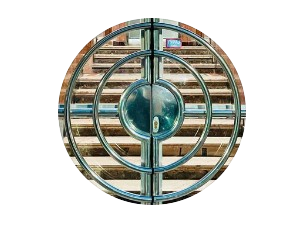Terazije and Kopitareva gradina
Guide to the most beautiful doorways of Belgrade
I invite you to take an exciting walking tour through the neighborhoods of Belgrade located around Skupshtina. The focus of our exploration will be the doors, behind which not only architectural masterpieces but also pieces of history are hidden. The duration of the route will be 1-2 hours, depending on the time you spend at each location. I tried to select the most impressive entrance groups for the route that will surely not leave you indifferent. On the route you can use a map with all the locations marked.

On this route, we will explore the neighborhoods of Belgrade located on both sides of the Parliament - Terazije and Kopitareva Gradina. Today, these areas belong to the municipality of Stari Grad.
In the late 19th to the early 20th century, Terazije became the center of public life in Belgrade. The most famous hotels, bars, shops, and public buildings are located here. However, the settlement of this area began only in the first half of the 19th century. By the order of Miloš Obrenović, Serbian craftsmen started to move from the Savamala district to the territory where towers for supplying the population with drinking water were located. The Turkish term for such towers — terrazije — became the name of modern Belgrade's center.
On the other side of the Parliament is the district called Kopitareva Gradina, named after Jernej Kopitar, a Slovenian philologist and associate of Vuk Karadžić, a renowned reformer of the Serbian language and literature. The development of this area began in the first decades of the 20th century and has largely preserved its appearance to this day. Characterized by rows of low residential houses with courtyards facing the street, this area's buildings, in addition to their architectural value, also represent memorial objects of famous scientists, writers, artists, architects, and merchants. Besides the great names in science, in the early 20th century, other important residents of the capital also moved to Kopitareva Gradina: politicians, ministers, and city founders.
In the late 19th to the early 20th century, Terazije became the center of public life in Belgrade. The most famous hotels, bars, shops, and public buildings are located here. However, the settlement of this area began only in the first half of the 19th century. By the order of Miloš Obrenović, Serbian craftsmen started to move from the Savamala district to the territory where towers for supplying the population with drinking water were located. The Turkish term for such towers — terrazije — became the name of modern Belgrade's center.
On the other side of the Parliament is the district called Kopitareva Gradina, named after Jernej Kopitar, a Slovenian philologist and associate of Vuk Karadžić, a renowned reformer of the Serbian language and literature. The development of this area began in the first decades of the 20th century and has largely preserved its appearance to this day. Characterized by rows of low residential houses with courtyards facing the street, this area's buildings, in addition to their architectural value, also represent memorial objects of famous scientists, writers, artists, architects, and merchants. Besides the great names in science, in the early 20th century, other important residents of the capital also moved to Kopitareva Gradina: politicians, ministers, and city founders.
Reljina 4



We start our route near Terazije Square. Just one and a half centuries ago, there was a pond in the area between the current streets of Brancova, Lomina, Reljina, Prizrenska, and Sremska, into which water flowed from Terazije and Varoš gates. The then Belgrade rajah hunted turkeys and ducks in these swamps. As Belgrade expanded in the mid-19th century, the idea came to the city's administrator to drain this area. For almost 70 years, attempts were made to build urban structures here, but without success. In 1918, a decision was made to build a market, which was realized in 1920. Zeleni Venac, the Green Wreath, is the first market mentioned in historical sources alongside the Big Market. It got its name from the green metal wreath on the facade of the tavern that was located where the current McDonald's restaurant stands today.
On Reljina Street, along the Terazije Terrace, there is the corner house of Stevan Stevanović. It was built according to the design of the architect Leon Talvi in 1922. A small number of preserved archival documents testify to the stylistic inconsistency of Talvi, with a wide range of applied styles ranging from Secession and Academicism to Academic Modernism. His works also include the building for Nikodije and Marija Bogdanović in Vračar and the "Palace" hotel.
On Reljina Street, along the Terazije Terrace, there is the corner house of Stevan Stevanović. It was built according to the design of the architect Leon Talvi in 1922. A small number of preserved archival documents testify to the stylistic inconsistency of Talvi, with a wide range of applied styles ranging from Secession and Academicism to Academic Modernism. His works also include the building for Nikodije and Marija Bogdanović in Vračar and the "Palace" hotel.
Terazije 35



The building of the "Assicurazioni Generali" Insurance Company is one of the most prominent examples of academism in the interwar Belgrade architecture. It was constructed in 1930 according to the design of the distinguished Belgrade architect Milan Antonović. The client for this commercial building was the "Assicurazioni Generali" Insurance Company, founded in 1831 in Trieste.
The building significantly differs from Antonović's other projects, leading to the belief that, in this case, the architect impeccably fulfilled the wishes of his clients from Trieste. He was assisted in this endeavor by the Russian architect Ivan Rik, who also worked on the sculptures on the facade of the General Staff building in Belgrade.
The building significantly differs from Antonović's other projects, leading to the belief that, in this case, the architect impeccably fulfilled the wishes of his clients from Trieste. He was assisted in this endeavor by the Russian architect Ivan Rik, who also worked on the sculptures on the facade of the General Staff building in Belgrade.
Kralja Milana 2



The building of the Vuk's Foundation is one of the oldest and most valuable historical landmarks in Belgrade. After the Terazije Fountain, built in 1860, it is the oldest building on the Terazije plateau. The building was constructed in 1870-1871 according to the design of Alexander Bugarski, one of the greatest Serbian architects of the 19th century. The buildings of the National Theater, the New Court, 126 public and private buildings and many other buildings in Serbia and abroad were also built according to his designs.
Immediately after its construction, the building became the residence of the Russian Imperial Consulate in Belgrade. After 1877, it was adapted for the needs of the Institute for Serbian Orphans. From 1879 to 1952, the building housed the Ministry of Education. As the ministry expanded, there was a need for enlargement. The first significant decorative works in the interior were carried out by the artist Dragutin Inkiostri in 1906. You might recall his murals in Dimitrije Živadinović's house at Gračanička, 16. Most of the wall compositions were lost over time, and only the wall paintings in the passage leading to the courtyard survived. They were accidentally discovered in 1963 and cleaned. They allegorically depict Faith, Education, History, and Art.
The expansion of the courtyard wing and the remodeling of the main facade in a "Serbo-Byzantine" style were carried out in 1912 according to the design of architect Branko Tanazević. The asymmetrical composition of the facade skillfully combines neo-medieval polychromy, intertwined ornamentation, a trefoil pediment, and the coat of arms of the Kingdom of Serbia, along with modern-style pilasters. You will certainly recognize Tanazevic's handwriting in the facades of the Belgrade Telephone station buildings and the house of the Nikolich brothers.
The last adaptation for the ministry's needs - the addition of a new wing on Kraljice Natalije Street - was completed in 1924 according to the design of architect Žarko Tatić. Since 1988, the building has been handed over for use and management to the Vuk's Foundation.
Immediately after its construction, the building became the residence of the Russian Imperial Consulate in Belgrade. After 1877, it was adapted for the needs of the Institute for Serbian Orphans. From 1879 to 1952, the building housed the Ministry of Education. As the ministry expanded, there was a need for enlargement. The first significant decorative works in the interior were carried out by the artist Dragutin Inkiostri in 1906. You might recall his murals in Dimitrije Živadinović's house at Gračanička, 16. Most of the wall compositions were lost over time, and only the wall paintings in the passage leading to the courtyard survived. They were accidentally discovered in 1963 and cleaned. They allegorically depict Faith, Education, History, and Art.
The expansion of the courtyard wing and the remodeling of the main facade in a "Serbo-Byzantine" style were carried out in 1912 according to the design of architect Branko Tanazević. The asymmetrical composition of the facade skillfully combines neo-medieval polychromy, intertwined ornamentation, a trefoil pediment, and the coat of arms of the Kingdom of Serbia, along with modern-style pilasters. You will certainly recognize Tanazevic's handwriting in the facades of the Belgrade Telephone station buildings and the house of the Nikolich brothers.
The last adaptation for the ministry's needs - the addition of a new wing on Kraljice Natalije Street - was completed in 1924 according to the design of architect Žarko Tatić. Since 1988, the building has been handed over for use and management to the Vuk's Foundation.
Kralja Milana 1



The House of Miloš Savčić, built from 1924 to 1926 on the corner of Kralja Milana and Andrićev Venac (then Dobrinjska Street), stands out among the lesser-explored corner buildings in the central area of Belgrade. Its authors are the renowned Serbian engineer Miloš Savčić and the active Russian emigrant Evgeny Gulin.
Miloš Savčić was one of the most outstanding figures of his time. In half a century of fruitful work, he achieved more than one might think possible for a person of his age. Before World War II, he was 11th richest in Europe, and his business empire employed 50,000 people. He built the first steam lathe in Serbia, initiated the water supply and sewage system in Belgrade, co-owned three banks, founded the first insurance company in Serbia, and played a role in the establishment of the League of Nations. He served as Minister of Construction, a parliament deputy, mayor of Belgrade, and director of state railways.
Among his many accomplishments, Miloš Savčić was also an exceptional engineer. The exact number of buildings he constructed during his lifetime is unknown, but it is known to be several dozen or even more. Built during the economic and social prosperity of Belgrade, the building at Kralja Milana, 1 fits the typical dual-purpose construction of the interwar period: commercial use on the ground floor and apartments on the upper floors. The exterior design reflects an attachment to the preceding academic era.
Miloš Savčić was one of the most outstanding figures of his time. In half a century of fruitful work, he achieved more than one might think possible for a person of his age. Before World War II, he was 11th richest in Europe, and his business empire employed 50,000 people. He built the first steam lathe in Serbia, initiated the water supply and sewage system in Belgrade, co-owned three banks, founded the first insurance company in Serbia, and played a role in the establishment of the League of Nations. He served as Minister of Construction, a parliament deputy, mayor of Belgrade, and director of state railways.
Among his many accomplishments, Miloš Savčić was also an exceptional engineer. The exact number of buildings he constructed during his lifetime is unknown, but it is known to be several dozen or even more. Built during the economic and social prosperity of Belgrade, the building at Kralja Milana, 1 fits the typical dual-purpose construction of the interwar period: commercial use on the ground floor and apartments on the upper floors. The exterior design reflects an attachment to the preceding academic era.
Kralja Milana 9



Another masterpiece by Miloš Savčić is located a couple of houses away from the previous one. The Vračar Savings Bank Building is located on the corner of Kralja Milana and Kneza Miloša streets.
At the turn of the 19th and 20th centuries, more than 40 banks were operating in Belgrade, and some of them, after many years of successful business, built their own "houses," as they used to say. The rapid growth of Vračar Savings Bank began in 1904 when Miloš Savčić became the chairman of the board of directors. The Vračar Savings Bank Building was one of the first projects initiated by Savčić when he took over the leadership of the bank. Just as with the Ribarska Banja resort, for which he personally developed the spatial plan, he also played a role in the construction of the headquarters of this financial institution. However, Danilo Vladisavljević, who had previously collaborated with him, was chosen as the chief architect responsible for the building's construction.
The construction of the administrative building began in the spring of 1908 and lasted just over a year. Vladisavljević and Savčić opted for a conservative combination of Renaissance and Baroque elements. In the tradition of the time, it was conceived as a business-residential building consisting of two wings connected at the rounded main entrance at the corner of Knez Miloša and Kralja Milana streets. The part along Kralja Milana housed rented shops, while the wing towards Kneza Miloša was intended for reception halls and administrative offices of the Vračar Savings Bank. Large apartments were located on each floor and in the attic.
The building retained its business-residential purpose even after World War II, although the savings bank itself ceased its operations. Interestingly, one of the residents of this building was a pharmacy, which, despite changes in ownership structure, still operates in the same location today. This is the famous "Prvi Maj" (First of May) 24-hour pharmacy.
At the turn of the 19th and 20th centuries, more than 40 banks were operating in Belgrade, and some of them, after many years of successful business, built their own "houses," as they used to say. The rapid growth of Vračar Savings Bank began in 1904 when Miloš Savčić became the chairman of the board of directors. The Vračar Savings Bank Building was one of the first projects initiated by Savčić when he took over the leadership of the bank. Just as with the Ribarska Banja resort, for which he personally developed the spatial plan, he also played a role in the construction of the headquarters of this financial institution. However, Danilo Vladisavljević, who had previously collaborated with him, was chosen as the chief architect responsible for the building's construction.
The construction of the administrative building began in the spring of 1908 and lasted just over a year. Vladisavljević and Savčić opted for a conservative combination of Renaissance and Baroque elements. In the tradition of the time, it was conceived as a business-residential building consisting of two wings connected at the rounded main entrance at the corner of Knez Miloša and Kralja Milana streets. The part along Kralja Milana housed rented shops, while the wing towards Kneza Miloša was intended for reception halls and administrative offices of the Vračar Savings Bank. Large apartments were located on each floor and in the attic.
The building retained its business-residential purpose even after World War II, although the savings bank itself ceased its operations. Interestingly, one of the residents of this building was a pharmacy, which, despite changes in ownership structure, still operates in the same location today. This is the famous "Prvi Maj" (First of May) 24-hour pharmacy.
Majke Jevrosime 8



The history of this building is also associated with the name of Miloš Savčić. In 1902, he and several prominent Belgrade engineers were elected to the temporary administration of the Association of Constructing Entrepreneurs of Belgrade, whose name and emblem you can see on the facade. The association aimed to protect the interests of its members and provide them with material and moral support, essentially functioning as one of Serbia's first labor unions. The names of the Association's leaders, founders, and benefactors are engraved on plaques inside the entrance group. These individuals and companies played a significant role not only in the construction of Belgrade but also in Serbia as a whole.
The house was built in 1929 with the funds of the Association of Constructors, and for some time, it was used by the Association itself. According to some information, it later became the residence of a Masonic lodge in Belgrade. Considering that Miloš Savčić was apparently a Mason, and where there are engineers and constructors, there are also "freemasons," this history seems quite plausible.
After World War II, Freemasonry transitioned from an open society to a secret one, and the building was nationalized and converted into a residential property.
The house was built in 1929 with the funds of the Association of Constructors, and for some time, it was used by the Association itself. According to some information, it later became the residence of a Masonic lodge in Belgrade. Considering that Miloš Savčić was apparently a Mason, and where there are engineers and constructors, there are also "freemasons," this history seems quite plausible.
After World War II, Freemasonry transitioned from an open society to a secret one, and the building was nationalized and converted into a residential property.
Svetogorska 12



Vladimir Vlajko Kalenić was a very wealthy, modest, and hardworking person. Born in 1851 in Mali Mokro Lug, he passed away in 1907 in Belgrade. He was a merchant, a shoemaker, an economist, and a great Serbian philanthropist who bequeathed everything he had to his homeland. On the plot of land Kalenić left to the city, a market was built in 1926. It still exists today and is named after the great benefactor Kalenić.
After his death, the "Vlajko Kalenić, Shoemaker and Economist from Belgrade Fund" was established, it helped poor students as well as humanitarian and cultural institutions. To this day, the fund supports outstanding students of the Faculty of Economics at the University of Belgrade with weaker financial positions.
In 1935, the Ministry of Education built two connected buildings at Svetogorska, 12 based on the design by engineer Radoslav R. Todorović. The symmetrical facade composition, executed in an academic style, features bronze busts of the benefactor Vlajko Kalenić, sculpted by Dragomir Arambašić, one of the founders of the Association of Artists in Belgrade. Special attention was given to the entrance and vestibule, where marble details, decorative ceramics, and ornamental plasterwork were skillfully crafted and integrated into a harmonious whole. The building houses 32 apartments that are rented out, and the proceeds are allocated to assist students, as per Kalenić's will.
After his death, the "Vlajko Kalenić, Shoemaker and Economist from Belgrade Fund" was established, it helped poor students as well as humanitarian and cultural institutions. To this day, the fund supports outstanding students of the Faculty of Economics at the University of Belgrade with weaker financial positions.
In 1935, the Ministry of Education built two connected buildings at Svetogorska, 12 based on the design by engineer Radoslav R. Todorović. The symmetrical facade composition, executed in an academic style, features bronze busts of the benefactor Vlajko Kalenić, sculpted by Dragomir Arambašić, one of the founders of the Association of Artists in Belgrade. Special attention was given to the entrance and vestibule, where marble details, decorative ceramics, and ornamental plasterwork were skillfully crafted and integrated into a harmonious whole. The building houses 32 apartments that are rented out, and the proceeds are allocated to assist students, as per Kalenić's will.
Đure Daničića 10



Engineer Petar Putnik built a residential house for himself and his family in the modern style at the corner of Djura Danicic Street, 10, and George Washington Street. It was initially constructed as a single-story building in 1910. In 1926, two additional floors and an attic were added while fully preserving the stylistic and architectural features of the authentic structure. During the facade restoration in 2018, ornaments from 1910 in the art nouveau style were discovered.
This is one of the first buildings in Belgrade to use reinforced concrete structures in its construction. At that time, there was only one other building in Belgrade that also employed reinforced concrete — the Belgrade Cooperative building.
This is one of the first buildings in Belgrade to use reinforced concrete structures in its construction. At that time, there was only one other building in Belgrade that also employed reinforced concrete — the Belgrade Cooperative building.
Bulevar despota Stefana 1



Immediately after the end of the First World War, in the first half of the third decade of the 20th century, Belgrade saw the construction of the largest and most representative private corner houses. One of the most prominent examples is undoubtedly the Djoka Cvetković House at the corner of Despota Stefana and Emilijana Josimovića streets.
Djoka Cvetković was a successful businessman. Since 1911, he managed the "Kolarac" restaurant and cinema in Belgrade and also excelled in trade. He is also considered one of the pioneers of Serbian cinema, having directed several documentary films. He constructed a magnificent five-story building in the center of Belgrade, renting out apartments and collecting rent.
In 1931, architect Franja Urban began designing one of the most successful corner buildings in the academic style. The building was completed in 1933 and somewhat represents an improved version of the project with a dominant dome. The oval windows under the dome resemble medallions held by children. Instead of a central window, Djoka Cvetković's monogram was placed, which was later removed. However, you can still find his monogram "ЂТЦ" on the entrance doors.
The ground floor of the building housed shops with galleries, while the upper floors were intended for residential purposes.
Djoka Cvetković was a successful businessman. Since 1911, he managed the "Kolarac" restaurant and cinema in Belgrade and also excelled in trade. He is also considered one of the pioneers of Serbian cinema, having directed several documentary films. He constructed a magnificent five-story building in the center of Belgrade, renting out apartments and collecting rent.
In 1931, architect Franja Urban began designing one of the most successful corner buildings in the academic style. The building was completed in 1933 and somewhat represents an improved version of the project with a dominant dome. The oval windows under the dome resemble medallions held by children. Instead of a central window, Djoka Cvetković's monogram was placed, which was later removed. However, you can still find his monogram "ЂТЦ" on the entrance doors.
The ground floor of the building housed shops with galleries, while the upper floors were intended for residential purposes.
Free online guides
to the most beautiful doorways of Belgrade
For more beautiful door locations follow us on Instagram.
Join us on a daily door exploration – we share one post every day.
You can also find much more locations for you walks on our Google Map.
Join us on a daily door exploration – we share one post every day.
You can also find much more locations for you walks on our Google Map.
All rights reserved.
Any copying and reproduction of text, photos and/or graphic materials, including partial and in any forms,
without the written permission of the copyright holder is prohibited.
Any copying and reproduction of text, photos and/or graphic materials, including partial and in any forms,
without the written permission of the copyright holder is prohibited.





